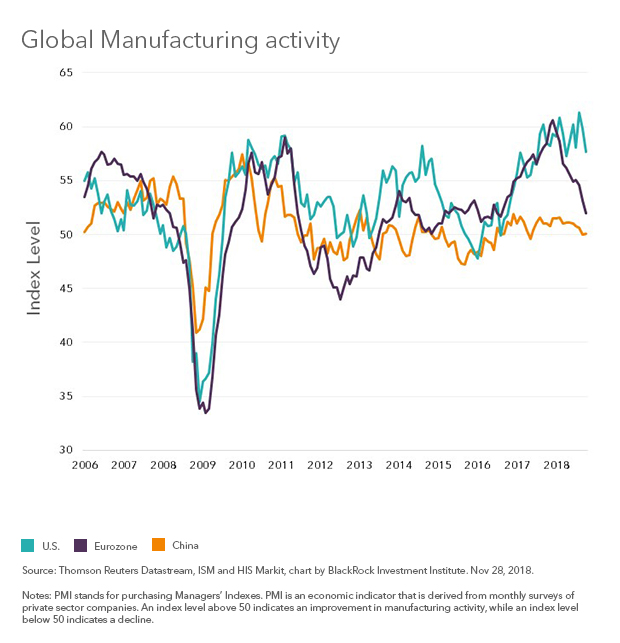There are few signs of a recession, but slowing growth is having an impact. Russ explains why and what steps to take.
The global economy is slowing, a fact not lost on investors. January’s faith in a global synchronized recovery has given way to nagging concerns over “peak growth.”
Back in August I highlighted the potential for economic deceleration. At the time I highlighted three warning signs: weakness in non-U.S. economies, negative economic surprise indexes and softer manufacturing and housing. Unfortunately, the last three months seem to have confirmed the early warning signs.
1. Global manufacturing looks to have peaked.
It now looks even more likely that global manufacturing peaked in early 2018 (See Chart 1). Moreover, while China and Europe rolled over earlier this year, the United States is no longer immune. The ISM New Orders Index, a good leading indicator for manufacturing and the broader economy, is slipping: It is now at its lowest level in 18 months, before the “sugar-high” of last year’s tax cut, although it is still comfortably over 50.
2. Financial conditions are getting tighter.
Higher rates, a stronger dollar, a more volatile stock market and less benign credit markets equal more expensive and less available money, i.e. a tighter financial conditions. This is evident in a number of indicators, including the Goldman Sachs Financial Conditions Index (GSFCI). Tighter financial conditions don’t just impact financial assets, but also the real economy. As borrowing costs rise, confidence is challenged and credit growth decelerates.
3. Housing is looking ever more challenged.
Regardless of the metric you pick, U.S. housing is softening. Prices and sales are decelerating, while starts and building permits are both weakening. This is important for two reasons: Housing tends to have a “multiplier effect” on other consumption and it often leads the broader economy.
4. Shifting preferences
To be clear, there are few obvious signs of an imminent recession. Household consumption has been uncharacteristically strong, at least relative to the post-crisis environment. Fourth quarter growth is still expected to come in at a relatively healthy 2.5%. The problem: That is probably as good as it gets for a while. A growing conviction in a slowdown is clear in recent investor behavior.
During the past three months, cyclical sectors, such as energy, materials and technology, have fallen by at least 10% (Source: Bloomberg, as of 11/27/18, based on relevant S&P sector indexes). Conversely, more classic defensive sectors, notably utilities and consumer staples, have defied the broader market and posted positive gains. Nor is the trend limited to stocks. In contrast to the pattern earlier in the year, growth sensitive bonds– i.e. high yield — have been under pressure as well. At the same time, investors are starting to be tempted by traditional, safe-haven bonds. After soaring earlier in the year, long-term Treasury yields have been contained in recent months.
To the extent growth is likely to decelerate further from here, I would continue to lean towards lower-beta, i.e. more defensive stocks, along with a greater emphasis on quality. I would define the latter as companies with low leverage and the ability to maintain pricing power and earnings. The hope is that these segments of the market provide for a more robust portfolio, even if “peak growth” morphs into the “R” word.
Russ Koesterich, CFA, is Portfolio Manager for BlackRock’s Global Allocation team and is a regular contributor to The Blog.
















